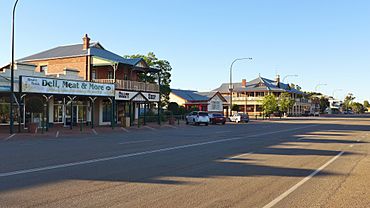Bruce Rock, Western Australia facts for kids
Quick facts for kids Bruce RockWestern Australia |
|||||||||
|---|---|---|---|---|---|---|---|---|---|

Johnson Street, Bruce Rock, 2014
|
|||||||||
| Established | 1913 | ||||||||
| Postcode(s) | 6418 | ||||||||
| Elevation | 276 m (906 ft) | ||||||||
| Area | [convert: needs a number] | ||||||||
| Location | |||||||||
| LGA(s) | Shire of Bruce Rock | ||||||||
| State electorate(s) | Central Wheatbelt | ||||||||
| Federal Division(s) | O'Connor | ||||||||
|
|||||||||
Bruce Rock is a town in the eastern Wheatbelt region of Western Australia. It is about 243 kilometers (151 miles) east of Perth. The town is the main center for the Shire of Bruce Rock. It is also about 48 kilometers (30 miles) southwest of Merredin.
Contents
History of Bruce Rock
How Bruce Rock Got Its Name
The town was first known as Nunagin or Noonegin. This name caused confusion with other towns like Narrogin and Nungarin. Because of this, the name was changed to Bruce Rock. The new name comes from a large granite rock feature near the town.
The rock itself was named after John Rufus Bruce. He was a sandalwood cutter who worked in the area. He was active in the region around 1879. The townsite was officially established in 1913.
Notable Events and People
A famous Australian painter, John Perceval, was born in Bruce Rock in 1923.
In 1932, the Wheat Pool of Western Australia decided to build two grain elevators in the town. These elevators help store grain from local farms. They were placed at the railway siding.
Bruce Rock won a special award in 2003. It received the 'Tidy Town' award for the Wheatbelt region. This happened after the community worked to improve older buildings. They also added new landscaping and built an amphitheatre.
Economy and Farming
The economy of Bruce Rock mainly depends on farming. Farmers in the area grow different types of cereal crops. The most common crop is wheat. Other crops include barley, lupins, and peas.
Farmers also raise animals in the area. These include sheep, goats, and pigs. The town is an important place for Cooperative Bulk Handling. This means it's a major collection point for grain from local farms.


